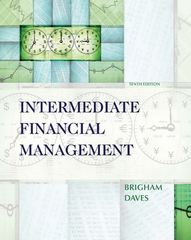Question
1. What is the value of a land that will generate Taka 1,00,000 per year for ever? The required return per year is 14.25 percent.
1. What is the value of a land that will generate Taka 1,00,000 per year for ever? The required return per year is 14.25 percent. 2. If a contract is expected to generate the following net cash flows and the expected return is 16 percent, what is the present value of the contract? Year 1 Taka 26,000, year 2 Taka 26,000, year 3 Taka 28,000, year 4 Taka 38,000, and year 5 Taka 45,000. 3. What is more valuable (a) Taka 1,50,000 per year for ever or (b) An annuity of Taka 2,80,000 for 4 years? Annual rate is 20 percent. 4. A bank says that it will credit depositors with 10 percent annual interest on a CONTINUOUS basis. If you make a deposit of Taka 30,000 in the account for 6 years, how much will be the accumulated value in the account? 5. (a) What is the yield to maturity of a bond that has 5 years left to maturity, has 12.5 percent coupon and a face value of Taka 1,000, and market price is Taka 903.74? (b) Assume everything else remains unchanged. This is year 2021. What is the expected price of the bond exactly one year later? (c) What is the expected capital gain if the investor decides to hold the bond for another year? (Assume everything else remains unchanged. This is the year 2021. The investor holds the bond till 2022) 6. Determine the fair value of a stock when the following information is known. Expected dividend: Cash 12.50. The required return is 28 percent and the growth rate in dividend is 12 percent. 7. Avaya Corporation has a target capital structure of 40 percent debt and 60 percent equity. Current share price in the market is Taka 450. EPS for the latest year is Taka 120 and 50 percent is expected to be paid out as a dividend. The firms usual ROE is 25 percent. The 50 % payout ratio is normal for the company. The YTM on its bonds is 16 percent and its marginal tax rate is 40 percent. a) Determine the cost of retained earnings, ke. b) What is the WACC of Avaya? 8. You are thinking of buying a luxury car and it costs Tk 28,00,000. The car dealer offers an amortization program where you will pay Tk 3,00,000 up front and pay the rest in 5 equal annual installments. The rate will be 14.5 percent. a. What is your annual payment? b. Build an amortization table? Circle the amount due at the end of the third year. 9. Using the following information about possible returns on investment next year, determine the expected return and standard deviation of returns: Scenario Return Probability Highly optimistic 64% .10 Optimistic 30 .20 Average 25 .35 Below average 12 .20 Pessimistic -10 .15 10. Using a reinvestment rate of 18 percent, determine the modified IRR with the following cash flow stream. Year 0 Year 1 Year 2 Year 3 Year 4 Year 5 -52,000 10,000 30,000 30,000 25,000 20,000 11. Determine geometric average return from the following numbers: Year return 2008 16.4% 2009 27.45 2010 33.22 2011 -2.07 2012 21.22 2013 42.09 2014 55.34 2015 - 7.77 2016 -10.25 2017 11.88 12. Using the returns in the preceding problem, determine the arithmetic average return and standard deviation of returns. 13. (a) Identify which project is preferred, given the following information about projects A and B. Project Expected Return Standard Deviation A 20% 32% B 26% 38% In addition to the values provided in the previous problem, the following information is provided: Correlation between returns of A and B = -.75 (b) If you form a portfolio of two assets as paired above with 40% of assets invested in the first asset, what is the standard deviation of this portfolio? (c) Comparing among single asset A, B, and the combination of A and B as stated above, what should a rational investor choose? Explain why. 14. The following are the cash flows for two mutually exclusive projects under consideration. The projects are considered average risk projects. The companys WACC is 16 percent. Year 0 Year 1 Year 2 Year 3 Year 4 Cash flows of A (14,000) 10,000 8,000 6,000 3,000 Cash flows of B (12,500) 4,000 6,000 9,000 9,750 a. Determine the IRR values for the two projects. b. Draw a figure of NPV profiles and show which project creates more value at the firms cost of capital. (Figures dont have to be exact, use discount rates of 10%, 15%, 20%, and 25%. Consistency in the graph expected.) c. Determine the exact cross-over rate.
Step by Step Solution
There are 3 Steps involved in it
Step: 1

Get Instant Access to Expert-Tailored Solutions
See step-by-step solutions with expert insights and AI powered tools for academic success
Step: 2

Step: 3

Ace Your Homework with AI
Get the answers you need in no time with our AI-driven, step-by-step assistance
Get Started


